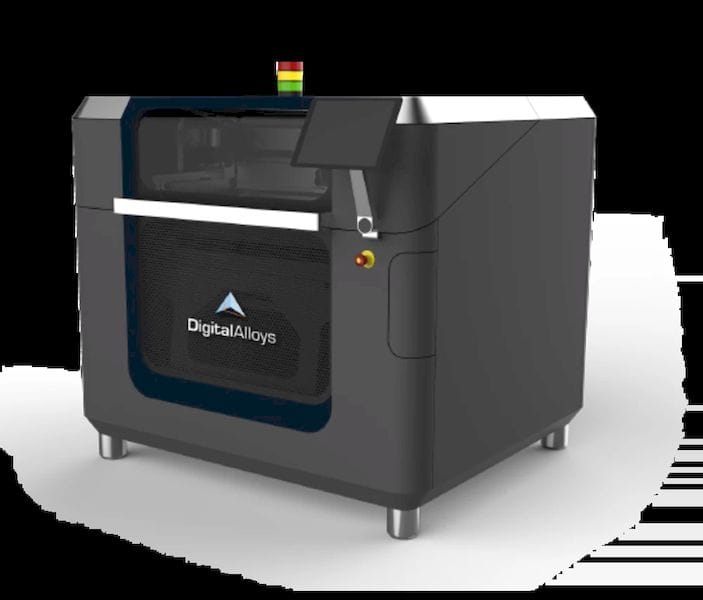
In the past two years, we’ve seen a number of new metal 3D printing technologies emerge, looking to take on more established, legacy processes.
These range from variations on fused deposition modeling and binder jetting to inkjet printing and digital light processing. Now, a new challenger has entered the ring with a totally unique metal 3D printing technology and some pretty hefty financial backing.
Boston-based startup Digital Alloys has announced a Series B round of funding to the tune of $12.9 million. With this latest round led by G20 Ventures and with participation from Boeing HorizonX Ventures, Lincoln Electric, and Khosla Ventures, this brings the startup’s total funding to $17.9 million, since Digital Alloys was established in 2017.
We spoke to Duncan McCallum, CEO of Digital Alloys, to learn about the company’s Joule Printing process and its future plans.
Like a Toaster, But It 3D Prints Metal
The army of new metal 3D printers that have emerged in recent years are all aiming to address the issues presented by legacy metal additive manufacturing (AM) technologies, such as speed, material capability, cost, size, quality and repeatability. In this way, the case of Digital Alloys is no different.
“When you talk to manufacturers—and we’ve talked to over 250 now—and you ask them what they’re actually doing with 3D printing in production, the answer is usually ‘very little,’” McCallum explained. “There are three primary reasons for that. One: it’s much too expensive with existing approaches to metal 3DP. Two: the current approaches are too slow. Three: [metal 3D printers] are complicated and unreliable.”
In contrast, joule 3D printing is meant to be cheaper, faster, simpler and more reliable than other approaches. The way that it achieves this is through a focus on the method for heating the metal feedstock and exactly what type of feedstock it uses. Unlike powder bed fusion systems—which use very expensive, specially refined metal powders—Digital Alloys’ process prints with metal wire, already widely available at low prices in a variety of materials.
It also doesn’t use a laser or electron beam to melt the wire, but instead relies on resistive heating, also known as “Joule” or “Ohmic,” wherein an electric current is passed through a conductor to heat the metal wire.
“It’s like the coil in a toaster oven,” McCallum said. “What’s great about joule printing and joule heating is that the current is inside the wire. The wire is heated from within. There’s no thermal time constant. You can heat the wire instantly with very low power. That gives you big benefits in speed.”
With faster printing times, productivity is increased, thus allowing the machine to pay for itself more quickly. And it does so using a precision motion system.
Closed Loop Control
Altogether, McCallum described the entire process as “very simple,” which not only improves the odds of reliability, but also makes it possible to introduce something yet to be seen in the metal AM space: closed loop control.
Systems manufacturers are increasingly introducing new monitoring technologies into their machines in order to enhance repeatability. These include a slew of sensors, cameras and software that perform such functions as measuring the intensity of light generated from a laser melting metal powder in order to determine the exact heat of the melt pool, as it sprays and splatters molten droplets in the build chamber.
As advanced as these methods have become, most metal 3D printing technologies are notoriously unreliable. Parts must often be printed numerous times to achieve the optimal print parameters, support structures and object orientation. The difficulty lies in the fact that the physics of energy beams heating metal powders is extremely complex, leaving companies like 3DSIM (since acquired by ANSYS) to create elaborate algorithms that can simulate the printing process to better improve the odds of a good print.
Joule printing, on the other hand, is said to be simple enough to be more closely controlled and monitored. McCallum says that, with Digital Alloys’ process, it’s possible to know exactly where each voxel is because of printhead’s contact with the wire. The amount of metal deposited is easily determined due to the machine’s precision wire feed system. How much energy is being used to heat the wire is known because heating is performed with an electric circuit.
“We can measure all of those things precisely in real time and use those parameters to control the process to deliver very high-quality printed metal parts repeatedly, easily and without a lot of the complex steps that are required in binder jetting or some of the other processes,” McCallum said. “It’s the only metal printing technology in the world where you can measure exactly what’s happening in the melt pool.”
The one almost-exception may be Markforged, which previously claimed to be developed a closed-loop system for its composite AM technology. Because Markforged’s metal 3D printing process is based on a similar platform, it may be possible that the company hopes to bring closed-loop control to its Atomic Diffusion AM systems. However, those prints still need to be fired in a furnace. According to McCallum, there is no heat treatment required for Joule-printed parts in order to achieve full density.
Read more at ENGINEERING.com











Aerosint and Aconity have proven out their work in multi-metal powder deposition 3D printing.